Abstract
Four water-solubleFusarium metabolites (fumonisin B1, fusaric acid, butenolide and moniliformin), water-insoluble pigment (8-O-methylbostrycoidin), and anAlternaria metabolite (AAL-toxin) were tested for relative cytotoxicity to five established mammalian cell lines. Butenolide was the most cytotoxic to all five cell lines. LC50s were; 1 μg/ml to rat hepatoma (RH) (tumors derived from parenchymal cells), 7 μg/ml to baby hamster kidney (BHK-21) fibroblast cells, and 15 μg/ml to McCoy mouse (MM) fibroblast cells: LC100s were 1 μg/ml to Chinese hamster ovary (CHO) fibroblast cells, and 5 μg/ml to dog kidney (MDCK) fibroblast cells. Fusaric acid was cytotoxic to the MDCK, MM, RH, and CHO cell lines; moniliformin was cytotoxic to the RH, CHO, and MDCK, cell lines. The pigment, however, was cytotoxic only to RH and CHO cell lines. Fumonisin B1 and a related toxin, AAL-toxin, at a high dose level (100 μg/ml) were not cytotoxic to the RH, BHK, MM, CHO and MDCK cell lines. T-2 toxin was used as a positive control, and inhibited all cell lines at the nanogram level. The difference in response of these five cell lines to the toxic metabolites, that were noted in this study, was then used to evaluate nine HPLC fractions obtained from a methanol-water extract of anF. moniliforme culture. The results indicated that this type of cytotoxicity assay may be useful in following the isolation of metabolites from extracts ofFusarium culture, especiallyF. moniliforme.
Similar content being viewed by others
References
Babich H, Borenfreund E (1990) Cytotoxic effects of food additives and pharmaceuticals on cells in culture as determined with the neutral red assay. J Pharm Sci 79:592–594
Cutler HG (1984) Biologically active natural products from fungi: templates for tomorrow's pesticides. Amer Chem Soc Symp Ser 257:153–170
Grove FG, Mortimer PH (1969) The cytotoxicity of some transformation products of diacetoxyscirpenol. Biochem Pharmacol 18:1473–1478.
Joffe AZ (1986) Detection of fusariotoxin-bioassay methods. In Joffe AZ ed Fusarium species-their biology and toxicology. John Wiley and Sons, NY, pp 136–152
Robb J, Norval M (1985) The use of a cytotoxicity test as a screening test for mycotoxins. In Lacey J (ed) Trichothecene and other mycotoxins. John Wiley and Sons, NY, pp 375–380
Robb J, Norval M, Neil WA (1990) The use of tissue culture for the detection of mycotoxins. Lett Appl Microbiol 10:161–165
Seymour FR, Slodki ME, Plattner RD, Jeanes A (1977) Six unusual dextrans: Methylation structural analysis by combined GLC-MS of per-O-acetyl-aldonitriles. Carbohydr Res 53:153–166
Shier WT, Abbas HK, Mirocha CJ (1991) Toxicity of the mycotoxins fumonisins B, and BZ andAlternaria alternata f. sp.lycopersici toxin (AAL) in cultured mammalian cells. Mycopathologia 116:97–104
Steyn PS, Wessels PL, Marasas, WFO (1979) Pigments fromFusarium moniliforme Sheldon. Structures and13C nuclear magnetic resonance assignments of an Azanapthaquinone and three naphthaquinones. Tetrahedron 35:1551–1555
Ueno Y (1983) Biological detection of trichothecenes. In; Ueno Y. Trichothecenes. Elsevier, Amsterdam, pp 125–133
Vesonder RF (1986) Moniliformin produced by cultures ofFusarium moniliforme var. isolated from swine feed. Mycopathologia 95:149–153
Vesonder RF, Peterson RE, Plattner RD, Weisleder D (1990) Fumonisin B, isolation from corn culture, and purification by high performance liquid chromatography. Mycotoxin Res 6:85–88
Vesonder RF, Labeda D, Peterson RE (1992) Phytotoxic activity of selected water-soluble metabolites ofFusarium againstLemna minor L. (duckweed). Mycopathologia 11:185–189
Author information
Authors and Affiliations
Rights and permissions
About this article
Cite this article
Vesonder, R.F., Gasdorf, H. & Peterson, R.E. Comparison of the cytotoxicities ofFusarium metabolites andAlternaria metabolite AAL-toxin to cultured mammalian cell lines. Arch. Environ. Contam. Toxicol. 24, 473–477 (1993). https://doi.org/10.1007/BF01146164
Received:
Revised:
Issue Date:
DOI: https://doi.org/10.1007/BF01146164




